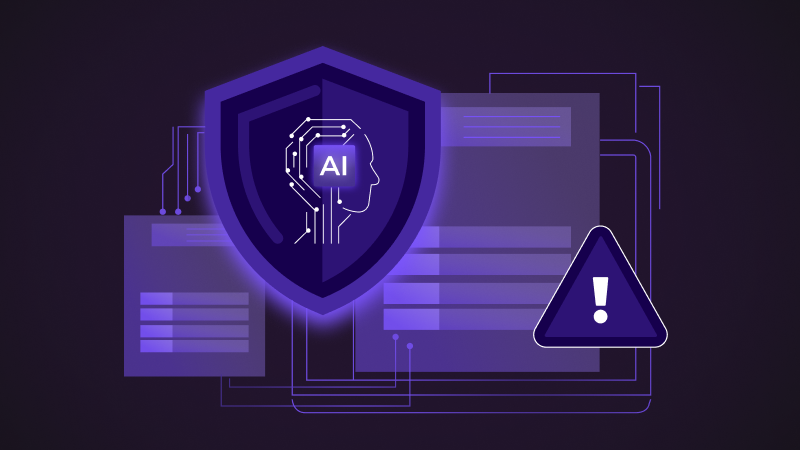Artificial intelligence has become embedded in all aspects of life and work, including how we serve customers, analyze risk, detect fraud, and even write code. Despite all the potential of AI, it comes with a brutal truth: AI security concerns are growing as fast as the technology itself, and sometimes, in places least expected.
AI initiatives can run into many potential security roadblocks, such as disclosing sensitive information in the data pipelines that power AI models or over-relying on risky shadow IT in everyday operations in an effort to become more efficient.
In this article, we will delve into:
- What shadow AI is and why it introduces unmanaged risk
- What are some data security challenges hidden within AI pipelines?
- How model integrity and supply chain attacks can sabotage AI outcomes
- Steps to address these AI security concerns before they become the next breach headline
Everybody wants to tap into the power of AI, but understanding its potential vulnerabilities will go a long way in helping you protect your organization and your customers with confidence.
The Hidden Expansion of AI Workloads
One of the fastest-growing AI security concerns is shadow AI, which refers to the unauthorized use of AI without direct permission from security and compliance teams. Think of a data scientist quickly spinning up an LLM API to speed up customer support analysis, or a developer grabbing a third-party GenAI plugin to draft code without consulting the security team. While these acts may have good intentions, they can quietly introduce unmanaged risks into your environment.
Up to 80% of enterprises have AI systems accessing sensitive or regulated data [source]. Still, many of these organizations don’t have a clear policy for securing or monitoring this type of activity. Shadow AI often skirts past data governance policies, which can result in:
- Regulated data being fed into LLMs or SaaS APIs without proper anonymization
- A lack of encryption for sensitive data in inference and training
- Inadequate auditing of who can access which models and for what purpose
All of this is concerning, particularly when just a quarter of leaders think their organizations are prepared to address governance and risk issues related to GenAI adoption [source]. It’s a disconnect that creates fertile ground for breaches stemming from well-meaning but unmanaged AI initiatives.
Challenging the Fuel Behind AI Models
Every AI system relies on a steady flow of data to function, but that data might include personal details, proprietary business information, or regulated records. If your data pipelines don’t have the right security controls in place, it’s easy to unintentionally put your organization at risk.
What makes it difficult to police is that these concerns can (and often do) begin with seemingly harmless shortcuts meant to improve productivity. We’re talking about things like:
- Feeding training models with personal customer or healthcare data without making sure it’s encrypted first.
- Running workloads for development and production in the same environment, creating accidental data leakage.
- Sharing API keys and secrets in Slack or email so teams can move faster but bypassing critical security checks in the process.
Individually, these actions can seem harmless. But together, they can quietly open the door to data exposure, compliance issues, and breaches that could have been avoided with the proper guardrails in place.
One telling example involves customer service LLMs trained on sensitive ticket data, including personally identifiable information (PII). Without masking or encryption, that data can be exposed in AI outputs or even leaked via prompt injection attacks, resulting in regulatory non-compliance and damage to the organization’s reputation.
Your organization’s data is the fuel for AI models. Ensuring that fuel is handled securely through encryption, access controls, and proper segregation isn’tt just a best practice, it’s a foundational element of building trustworthy AI.
As organizations seek guidance on risk management in their pipelines, NIST’s AI Risk Management Framework [source] provides practical approaches to align AI data practices with organizational security needs.
The Hidden Risks Inside AI Models
While data pipelines receive plenty of deserved attention, AI models themselves can also be exploited. Malicious actors can tamper with models during their development, manipulate them while they’re being transferred, or infiltrate them with malicious data during the training stage.
Examples of AI security concerns within models include:
- Model poisoning attacks, where manipulated data is injected into training to create hidden backdoors that can be exploited later
- Model extraction attacks, where models are queried repeatedly to reconstruct its logic or extract proprietary IP
- Model supply chain attacks, where publicly available or third-party models are downloaded with embedded malicious payloads that activate in production
According to the MITRE ATLAS knowledge base [source], attackers actively explore these methods, and many enterprises don’t have the defenses in place to deal with them. Further, as models become more complex and difficult to inspect, the risk of hidden vulnerabilities within the AI supply chain will only grow.
To combat this, your organization should consider:
- Verifying the integrity of models received from third parties
- Applying encryption for models at rest
- Monitoring for unusual inference patterns that may indicate extraction attempts
How Do You Address AI Security Concerns?
AI can transform your business in many ways, but it can just as easily create new vulnerabilities that traditional security tools and processes overlook. In today’s modern era, organizations must prioritize AI security to address these concerns before they compromise operations, customers, or compliance posture.
At a high level, it’s important to remember that:
- Shadow AI creates hidden risk, so ensure you have visibility over all AI workloads in your environment.
- AI pipelines handling sensitive data must be secured with encryption and access controls to prevent leakage and non-compliance.
- Models are a new attack surface, so protect them with integrity verification, monitoring, and encryption.
Addressing AI security concerns now will set you up to safely scale AI while building trust among internal stakeholders and customers.
Looking to secure your AI workloads? Fortanix helps enterprises manage encryption, secure sensitive data in AI pipelines, and protect models throughout the entire AI lifecycle.
Request a demo to see how Fortanix Data Security Manager can help your team secure GenAI and machine learning workloads so you can scale AI securely and confidently.











